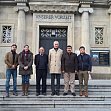Archaeological Survey in Khalifan (Autonomous Region of Kurdistan, Iraq)
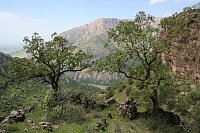
Overview Khalifan
The Khalifan Survey is located in an almost unexplored area of the Zagros Mountains in northern Iraq. The few excavations in this region took place as early as the first half of the 20th century and focused on prehistoric sites such as Banahilk (Late Neolithic) and Zawi Chemi (Early Neolithic). Later research by the Iraqi Antiquities Authority was mainly related to the construction of the Bekhme Dam on the Great Zab. By the beginning of the Khalifan survey in 2014, in total ten settlement sites and caves were known in the Khalifan district, whose find material was often undateable. The few dating details that were given point for individual sites to the late 3rd/early 2nd millennium BC or to the Islamic period.
The most recent field surveys in 2014-2018 now show that even in this rugged mountain region without extensive agricultural areas, the settlement pattern can be further condensed and the considerable chronological gaps can also be gradually closed. In the meantime, there are clear indications that the area was also settled in the late 2nd and 1st millennia BC. This period is of particular interest with regard to the historical sources on the Urartian-Assyria conflict in the Neo-Assyrian period, because the Khalifan district is usually defined on the historical maps of this period as an empty buffer zone between the two great powers Assyria and Urartu. At present an important focus of research is also the fortifications, some of them massive, which have become known for the first time in this area and can be compared well with Late Bronze Age and Iron Age fortifications from the western Urmia region.
The project under the direction of Dr Claudia Beuger is taking place in cooperation with the General Directorate of Antiquities Erbil (by name Kaifi Mustafa Ali) and the Department of Antiquities Soran (by name Abdulwahhab Sulaiman Hasan). The work was made possible by funding from the International Office of the Martin Luther University Halle-Wittenberg (2014, 2017), the Franz-und-Eva-Rutzen-Stiftung (2016), Deutsche Orient-Gesellschaft e.V. (2015-2017, 2019), Gerda Henkel Foundation (2017-2019) and the Fritz Thyssen Foundation (2018-2019).
A new, important cooperation with the Scientific Research Center (SRC) of the University of Soran has been established in 2020. In close collaboration with Prof. K. Kolo, Dr. R. Hamad and Dr. O. Mahmoud (University of Soran), PD Dr. T. Kerig (CAU Kiel), Dr. Jutta Lechterbeck (University of Stavanger) and Dr. Tobias Helms (JGU Mainz) a distance learning curriculum on central topics in Near Eastern archaeology and archaeological working methods is currently being developed.
Publications:
C. Beuger/T. Helms/A. Suleiman/M. A. Dlshad/H. Hussein, Archäologische Forschungen im nordwestlichen Zagros, Vorläufige Ergebnisse aus den Feldbegehungen in Khalifan (Distrikt Soran), Mitteilungen der Deutschen Orient-Gesellschaft zu Berlin 147, 2015, 129-163.
C. Beuger/R. Heitmann/S. Schlüter/A. Suleiman/M. A. Dlshad/H. Rashid/ H. Hussein, Archäologische Forschungen im nordwestlichen Zagros, Bericht zum Khalifan-Survey 2016-2017, Mitteilungen der Deutschen Orient-Gesellschaft zu Berlin 150, 2018, 45-88.
C. Beuger, Im Land des Drachen – Überlegungen zu frühen Christen im Khalifan-Distrikt, in: K. Kaniuth/D. Lau/D. Wicke (Hrsg.), Übergangszeiten. Altorientalische Studien für Reinhard Dittmann anlässlich seines 65. Geburtstags, marru 1, 2018, 387-397.
C. Beuger, A bronze figurine from Gali Bla valley, Khalifan-district, Iraqi Kurdistan, (in prep.).
C. Beuger/R. Heitmann/S. Schlüter/A. Suleiman, Preliminary results of the Khalifan Survey Project 2014-2018 (Kurdistan Region of Iraq), Publications of 12th International Congress on the Archaeology of the Ancient Near East, held on 6.-10. April 2021 in Bolonga (in prep.).
Excavations in Pir Wali (Khalifan, Kurdistan Autonomous Region, Iraq)
Pir Wali is an approximately 0.6 hectare site that was first documented in the course of the Khalfian Survey Project in 2016. The site is situated on a narrow headland on the Rawanduz River (or Khalan Su), a tributary of the Great Zab. The area was and is massively threatened by gravel mining. However, it was precisely this dredging that brought an unusually large number of ceramic finds to light. Therefore it quickly became clear that this site should be given more attention. After preliminary investigations in 2017 and 2018, a four-week excavation campaign was carried out in autumn 2019.
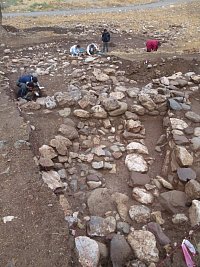
Pir Wali 2019, view of the massive architecture of the Late Assyrian layer.
The excavations have brought to light an unexpectedly dense sequence of building layers: several domestic building layers - according to C14-data dating 4th century BC to 2nd century AD - overlay on at least two Iron Age layers with massive structures. Due to the hillside location and proximity to the surface, a stratigraphic allocation of the numerous ceramic finds has so far only rarely been possible. However, during the excavations, two clearly separated ceramic horizons emerged, which could possibly be correlated with these two building layers. A corner of the wall with walls up to 1.5 m wide is to be connected with a finer, wheel-made fabric that fits well with the range of vessels of the Late Assyrian heartland (7th century BC). For the lower horizon, a coarse, hand-formed ceramic is characteristic, which corresponds to the so-called Late Western Gray Ware in Iran (8th century BC). The latter horizon may include the numerous finds of cowrie shells, carnelian beads, bronze rings, bosses, rosettes and fibulae, as well as the single seals or amulet finds that are known in northwestern Iran, especially from Iron Age graves. Furthermore, the ceramic finds suggest that the site has been used at least since the Late Early Bronze Age.
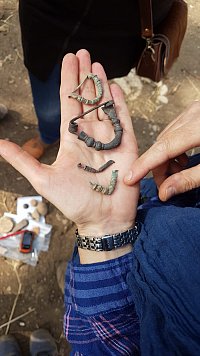
Pir Wali 2018, bronze fibulae (8./7.-5./4. BC; cf. F. Pedde, Vorderasiatische Fibeln, Von der Levante bis Iran, Abhandlungen der Deutschen Orient-Gesellschaft 24, 2000).
One of the central questions of the Khalifan Survey project was whether this area can still be defined as part of the Assyrian province of Ḫabruru, which is believed to be in the western Harir plain. Since Pir Wali is the only site with clearly Neo-Assyrian ceramics even after the Khalifan Survey has been completed, this should be denied. According to the current status of the investigations, Pir Wali is only interpreted as an Assyrian outpost. The project under the direction of Dr. Claudia Beuger takes place in cooperation with the General Directorate of Antiquities Erbil and the Department of Antiquities Soran. The excavations in 2019 were made possible by the support of the Gerda Henkel Foundation and the German Orient Society.
Publications:
C. Beuger/R. Heitmann/S. Schlüter/A. Suleiman/M. A. Dlshad/H. Rashid/ H. Hussein, Archäologische Forschungen im nordwestlichen Zagros, Bericht zum Khalifan-Survey 2016-2017, Mitteilungen der Deutschen Orient-Gesellschaft zu Berlin 150, 2018, 45-88.
C. Beuger/R. Heitmann/S. Pastwa/S. Schlüter/A. Suleiman, Assyrer im nordwestlichen Zagros? Bericht zu den Grabungskampagnen 2017-2019 in Pir Wali, Mitteilungen der Deutschen Orient-Gesellschaft 153, 2021 (in print).
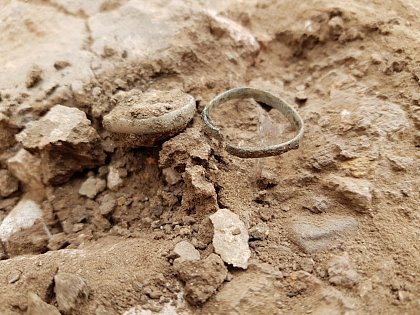
Pir Wali 2019, bronze rings in situ.





